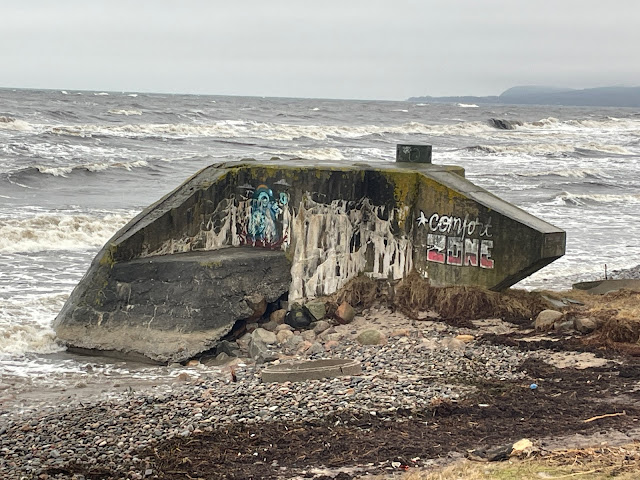After spending the last month shuttling between hospital and home, we decided that this was a good weekend to get out and see some more of Sweden.
Kristine and I had been watching a show called "Historien om Sverige" (The story of Sweden) which discussed Sweden's history from the stone age through to modern times. As we watched we made some notes about the places that we saw that looked interesting to visit. One such place was Kivikgraven or Kungsgraven (The Kivik Grave / The King's Grave).
It turns out that we had been there once before in April 2016 (https://puplettsinsweden.blogspot.com/2016/04/simrishamn-and-kivik-9-april.html) but we didn't remember much.
The boys decided to stay at home and play video games (surprise, surprise...) so Kristine and I took off towards Kivik on the south east coast of Sweden.
Malmö weather was fairly mild when we left, but the weather in Kivik reminded us that it was definitely still winter:
We found a park near the Kivikgraven and walked over to the site. You are able to go inside the grave, but unfortunately it was closed for winter. Kris and I didn't remember entering it last time either, so we checked the blog, and yep - last time we had come it was also closed for winter. Previously we had been able to walk up to the door of the monument, but now it was all fenced off and entry was only through a locked building. Oh well, guess we are coming back again later...
Kungsgraven, The Kings Grave, is believed to have been built in the early Bronze Age (around 1700-1000BC) and is a burial mound containing a large coffin. The inside of the grave contains many rock paintings representing animals and ships (which we couldn't see as we couldn't enter).
In the 1700s, the site was used as a quarry until the workers reached the cairn and the central coffin. The site has since been restored.
It is believed that at least four people, mostly teenagers, were buried in the coffin at various times throughout the Bronze Ages.
From the outside, the grave looks like a mound of stones:
The signs outside the mound tell that, while rock art was common in the Bronze Ages, it was not commonly found in tombs. The grave was named Kungsgraven as it was originally believed the be the grave of a king, however the original occupant appeared to be 13-15 years old. Outside the mound were signs of graves from 2000BC that appear to have been reused.
Throughout the years, the tomb was used for several burials, the latest known was in 700s when a man and dog were buried in the tomb.
The items buried with the teenagers, such as bronze, amber, weapons and jewelry indicate that they were from a social elite.
After a quick walk around the outside, we headed down to the beach, where the weather was whipping up the water:
We then decided to head up the coast a little to visit Haväng, a popular beach nearby. Despite it not really being beach weather (-1 and a little rainy) we decided to go for a walk to find the Havångdösen, which was a neolithic burial chamber from 3000BC.
After a couple of false starts, such as a private road and a muddy dirt track, we finally got a park at Haväng and were greeted with a path down to the beach. There were tourist signs pointing to the right, so we headed down to the sand and crossed a small bridge, heading south. We never saw the Havängdösen, because it turns out that it is just left of the carpark... Another reason to go back I guess.
The shed was used to house eel and trout caught by fishermen from the 1700s onward.
We then decided to head towards the hög stenar (high stones) a burial ground from the Iron Age. In order to get there we needed to climb up a hill and walk through some wilderness. After about half an hour we ended up in a cow paddock, somewhat near the stones. It was starting to get dark and we had about 45min walk back to the car, so we started on our way back - backing today 0 from 3 for things we wanted to see.























No comments:
Post a Comment